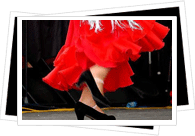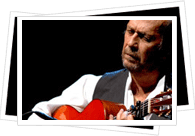 Flamenco personifies the fiery passion, artistry and culture of Andalusia. Full of expression and emotion, it is an infinitely complex art form that requires years of study and development by its performers. The roots of flamenco are not completely pinpointed, but it is believed that flamenco is the result of the blending of Moorish, Andalusian and Gypsy cultures.
Flamenco personifies the fiery passion, artistry and culture of Andalusia. Full of expression and emotion, it is an infinitely complex art form that requires years of study and development by its performers. The roots of flamenco are not completely pinpointed, but it is believed that flamenco is the result of the blending of Moorish, Andalusian and Gypsy cultures.
Flamenco encompasses music, dance and song. It could be the strumming of the Spanish guitar as chords form a stream of multifaceted sounds. It could also mean the melody of the singer, whose emotional words spring are drawn from deep within the gypsy soul. But usually the word flamenco brings to mind the image of a woman twisting and turning in dance. Embodying strength, emotion and power, her arms move gracefully as her heels drill into the floorboards in a power and higly compelling display.
 Flamenco music can be sung alone, which is actually how flamenco got its start. When accompanied, however, the guitar is by far the unrivaled favorite. Nevertheless, depending on the region you may also find the integration of other instruments, such as castanets, lutes and violins into the passionate flamenco melodies.
Flamenco music can be sung alone, which is actually how flamenco got its start. When accompanied, however, the guitar is by far the unrivaled favorite. Nevertheless, depending on the region you may also find the integration of other instruments, such as castanets, lutes and violins into the passionate flamenco melodies.
There is also Nuevo Flamenco (New Flamenco), which is a new variation of flamenco with more modern influences. Salsa, pop, jazz, rock and rumba music are just a few of the styles that have provided inspiration for this very current musical style that is climbing up the music charts and gaining worldwide popularity.
In Malaga, flamenco comes in different forms. There are folk dances that belong to specific towns in the Malaga region: rondeñas, verdiales, jaberas and malagueñas. These are all variations of the fandango until they evolved into what is now known as different kinds of flamenco.
When it comes to the flamenco of Malaga, the musician Juan Berva deserves much kudos. With his own distinct style, often described as "luminous," he worked fervently to bring flamenco to the international spotlight.